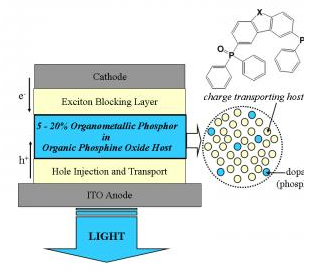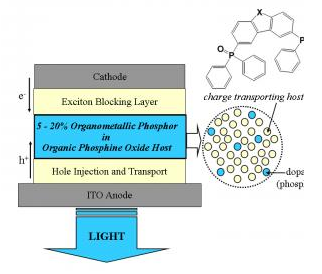New materials for high efficiency organic solid state lighting
A new organic molecule developed by PNNL (Pacific Northwest National Laboratory) scientists may significantly improve the efficiency of organic solid state lighting.
Direct conversion of electricity to light in “solid state” thin films of organic molecules occurs in organic light emitting devices which can be far more efficient than conventional “incandescent” light bulbs.
In an OLED, light emitting molecules harvest positive and negative charge carriers from oppositely charged electrodes to create excitons, which collapse to give light emission. By using organometallic phosphors, a photon can be emitted for every electron used so there is no wasted current.
But until now, no good host materials were available to transport the charge to blue phosphorescent light emitters. And, without an efficient blue component, it is not possible to generate the high quality white light required for indoor lighting. The PNNL team is solving this problem by linking small organic molecules together using inorganic “phosphine oxide” connecting units to make larger molecules that transport charge but do not interfere with the blue light emission process.
PNNL is a DOE Office of Science laboratory that solves complex problems in energy, national security, the environment and life sciences by advancing the understanding of physics, chemistry, biology and computation. PNNL employs 4,200 staff, has an annual budget of more than $725 million, and has been managed by Ohio-based Battelle since the lab's inception in 1965.
In an OLED, light emitting molecules harvest positive and negative charge carriers from oppositely charged electrodes to create excitons, which collapse to give light emission. By using organometallic phosphors, a photon can be emitted for every electron used so there is no wasted current.
But until now, no good host materials were available to transport the charge to blue phosphorescent light emitters. And, without an efficient blue component, it is not possible to generate the high quality white light required for indoor lighting. The PNNL team is solving this problem by linking small organic molecules together using inorganic “phosphine oxide” connecting units to make larger molecules that transport charge but do not interfere with the blue light emission process.
PNNL is a DOE Office of Science laboratory that solves complex problems in energy, national security, the environment and life sciences by advancing the understanding of physics, chemistry, biology and computation. PNNL employs 4,200 staff, has an annual budget of more than $725 million, and has been managed by Ohio-based Battelle since the lab's inception in 1965.


